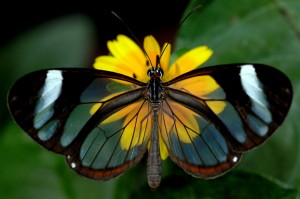One of the reasons I wanted to start contributing to a blog was to share experiences of life as a biologist and opportunities that I have had that are open to people inside and outside my field. One of these opportunities presented itself recently through an event called a BioBlitz.

This event is designed to bring scientists, naturalists, park personnel, and the community together in an effort to inventory species that exist within a designated area (typically a park or preserve). The inventory typically occurs over a 24 hour period, during which groups use different techniques to find and identify all of the mammals, plants, birds, reptiles, amphibians, arthropods, arachnids, and fungi as possible.

I really enjoyed my time and it allowed me to interact with scientists from different fields and people from the community while also contributing to a graduate student’s thesis. The bioblitz occurred at the Rushton Woods Preserve in Malvern, PA. I initially assisted with identifying bat species and floated to other groups throughout my time. In order to detect the bat species we recorded their calls using acoustic equipment placed in a truck with the microphone secured to the outside roof.

While we drove around the area, the microphone picked up bat calls that are used in echolocation. Echolocation occurs when a bat emits a call from their mouth or nose and the sound waves hit objects in the surrounding environment and bounce back to the bat. Using echolocation, bats determine the size, shape, and location of objects. Bats use echolocation to navigate and locate food in the dark. To learn more about bat echoloation: https://askabiologist.asu.edu/echolocation

Using this technique we were able to identify two species of bat based on the sound frequencies of the calls. The most common species we identified that were out foraging shortly after sunset were the big brown bat and the red bat.


This was my first time participating, and I only heard of bioblitz this year. On my way home, I found myself wondering about the origins of bioblitz and how common it is?
The name BioBlitz, was coined in 1996 by Susan Rudy, a U.S. National Park Service (NPS) naturalist, who took part in the first event of this kind. It was held at Kenilworth Aquatic Gardens, Washington D.C., and led by Sam Droege (USGS) and Dan Roddy (NPS). About 1,000 species of plants, animals, bacteria, protozoa, and fungi were identified that day (https://www.pwrc.usgs.gov/blitz/species.html).
Since 1996, bioblitz events have become more common occurring all over the United States, Canada, the UK, and Australia. Some bioblitz events occur every year, such as one put on at Hawai’i Volcanoe National Park, one by the Connecticut Museum of Natural History and the University of Connecticut (https://web.uconn.edu/mnh/bioblitz/; https://bioblitz2015.eeb.uconn.edu/), and the Rutgers-Newark bioblitz (https://www.njspotlight.com/stories/12/09/19/taking-stock-of-flora-and-fauna-at-rutgers-newark/). In May, National Geographic, through the Great Nature Project, performed a global bioblitz that identified 40,000 species (https://voices.nationalgeographic.com/2015/06/04/40000-observations-of-biodiversity-in-11-days/).

There have been several variations on BioBlitz that have sprung up over the years. The first was called Biodiverstiy days. It was started in Massachusetts after E. O. Wilson, a Harvard biologist, and wildlife expert Peter Alden developed a program to catalog organisms around Walden Pond in 1998. At Walden Pond there has been one other event like this to celebrate E. O. Wilson’s 80th birthday in 2009.
The second is performed on a blog. It is called Blogger Blitz, and people volunteer and pledge to conduct individual surveys of biodiversity. The results are then compiled and mapped to get an overall idea of the distribution and rough abundance estimates of particular species (https://wiki.tdwg.org/twiki/bin/view/Main/BioBlitz2010).
There is one commonality that makes bioblitz events and variations on it so successful, and it is community involvement. Having scientists, naturalists, and people from the community really helps to not only increase the amount of area covered (which leads to an increase in the number of species recorded), but also allows for the coming together of different perspectives and exchange of ideas. Everyone who attends learns something new and has an opportunity to share their ideas and learn about the local environment.
Other than recording observations on a sheet of paper, at some events they use an app called iNaturalist (iNaturalist.org). This allows for recording of data and also includes geographic coordinates. Scientists can also collect samples from the environment and perform DNA barcoding to accurately distinguish between species that look similar.
One of the main purposes of ecology is to understand more about the distribution and abundance of organisms. This is one way to record distribution and understand a bit about abundance of many species. Especially if many preserves and parks become involved all over the United States and beyond, we will continue to learn more about the distribution, occurrence, and patterns or organisms.
For more information on BioBlitz events:
https://www.pwrc.usgs.gov/blitz/
https://web.uconn.edu/mnh/bioblitz/
https://bioblitz2015.eeb.uconn.edu/
https://www.njspotlight.com/stories/12/09/19/taking-stock-of-flora-and-fauna-at-rutgers-newark/
https://voices.nationalgeographic.com/2015/06/04/40000-observations-of-biodiversity-in-11-days/
__________________________________________________________________________________________________
Websites and papers used:
Karns, Daryl R., Donald G. Ruch, Robert D. Brodman, Marion T. Jackson, Paul E. Rothrock, Peter E. Scott, Thomas P. Simon, and John O. Whitaker, Jr. (2006). Results of a short-term bioblitz of the aquatic and terrestrial habitats of otter creek, Vigo county, Indiana. Proceedings of the Indiana Academy of Science, 115:82-88
Lundmark, Cathy. (2003). BioBlitz: Getting into Backyard Biodiversity. Bioscience 53: 329
Laforest, Brandon J., Amanda K. Winegardner, Omar A. Zaheer, Nicholas W. Jeffery, Elizabeth E. Boyle, and Sarah J. Adamowicz. (2013). Insights into biodiversity sampling strategies for freshwater microinvertebrate fauna through bioblitz campaigns and DNA barcoding. BMC Ecology, 13:13
https://web2.uconn.edu/mnh/bioblitz/BioBlitzGuide.pdf
https://www.wildbirds.com/bioblitz/runabioblitz.html
https://askabiologist.asu.edu/echolocation
https://nicholas.duke.edu/eowilson/2015/day1lectureseries
Photo Credits:
Elizabeth Hagen. (2009, November 4). Bats. ASU – Ask A Biologist. Retrieved June 19, 2015 from https://live-askabiologist.ws.asu.edu/echolocation
https://www.cnhp.colostate.edu/batmatrix/speciesProfile.aspx?SpeciesID=2
https://biology.eku.edu/bats/redbat.html

